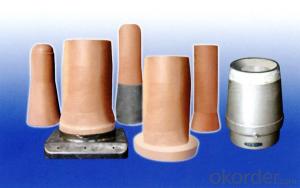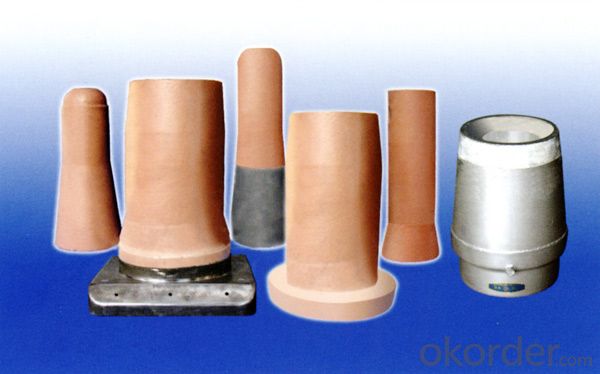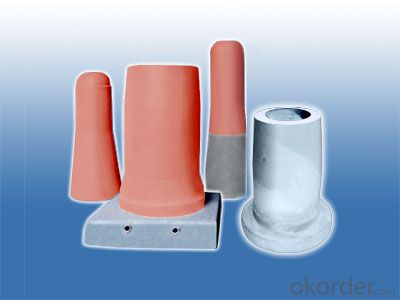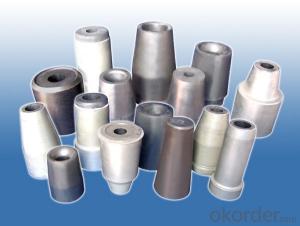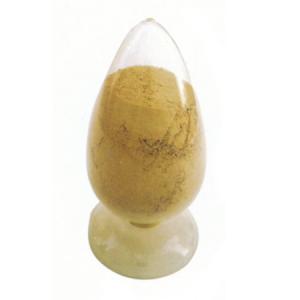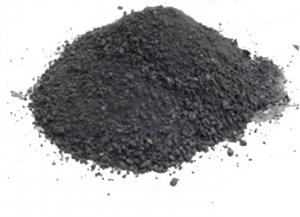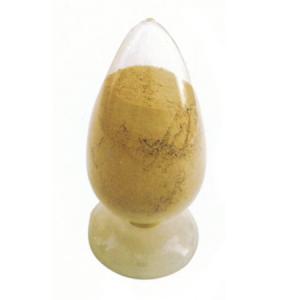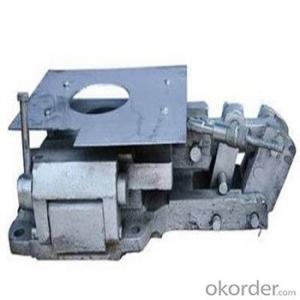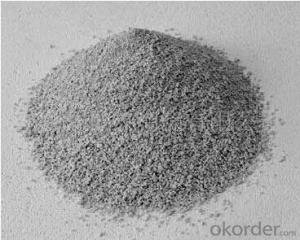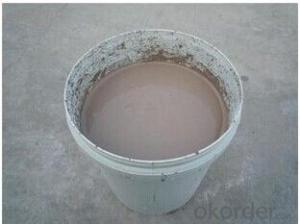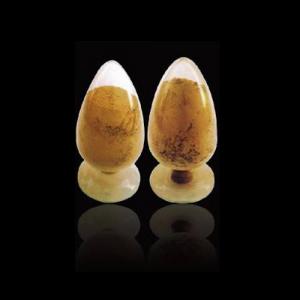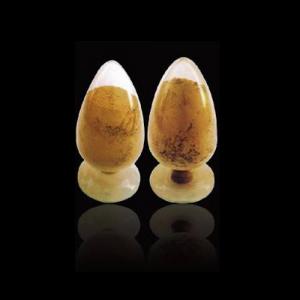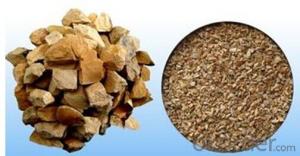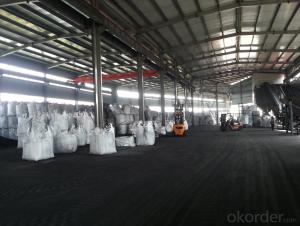Monolithic Refractories for Iron and Steel Industry - Refractory Tundish Upper Nozzle and Collect Nozzle
- Loading Port:
- Shanghai
- Payment Terms:
- TT OR LC
- Min Order Qty:
- 10 set
- Supply Capability:
- 50000 set/month
OKorder Service Pledge
OKorder Financial Service
You Might Also Like
Description:
Steelmaking tundish upper nozzle is an kind of quickchange nozzle,used together with tundish collect nozzle which produced by topcahse, with high purity zr 95% for steel continuous casting process
tundish nozzle is one kind of refractory alumina-zirconia-cartbon brick which are used for control the molten
steel in steel casting .we called is composite zirconia tundish nozzle
| Al2O3 % | Fe2O3 % | SiO2 % | TiO2 % | ZrO2 % | CaO % | MgO % | LOI % | Density g/cm³ | Proosity | fraclure strength Mpa | Application | |
| Body | 53.28 | 0.91 | 14.48 | 1.41 | 30.59 | 2.42 | 14.3 | 8.4 | general | |||
| Bowl struclure | 86.61 | 0.43 | 0.77 | 0.33 | 11.11 | 2.85 | 17.7 | 6.73 | general | |||
| Bowl struclure | 71.43 | 0.91 | 10.65 | 10.95 | 2.78 | 16.3 | 14.5 | Bowl struclure with serious corrosion | ||||
| Body | 63.15 | 1.51 | 6.83 | 0.87 | 3.25 | 22.13 | 2.6 | 16.24 | 8.67 | Inner part with serious corrosion | ||
| Liner | 64.1 | 0.81 | 4.06 | 4.94 | 0.12 | 0.32 | 22.5 | 2.4 | 16.7 | 7.2 | General anti-blocking | |
| Liner | 0.55 | 4.65 | 52 | 19.2 | 0.3 | 22.3 | 2.45 | 16.3 | 8.6 | High standard anti-blocking | ||
| Liner | 52.9 | 13.9 | 0.07 | 21 | 12.1 | 2.51 | 18.71 | 6 | Low carbon | |||
| Bowl struclure | 15.1 | 8.95 | 0.29 | 1.56 | 56.8 | 17.3 | 2.59 | 16.7 | 7.8 | Slag Containing |
Manufacturing and QC
1.Raw materials blending
Independent raw materials blending center to assurestrict control of materials quality.
2.Shaping
Isostatic pressing technoloty,with as 1000 tons of pressure to assure the homogenous bulk density of each product.
3.Machining
To assure the uniform shape,dimension and dimension tolerance of each product.
4.X-ray defect inspection
To assure all products supplied to our customers without any defect and to prevent the un-countable feconomic loss for our customers.
5.Physical and chemistry analysis
To assure all products meet the physical and chemistry characteristics.
6.Packaging
The world-class for packaging to assure the safety transportation.
- Q: How do monolithic refractories resist chemical corrosion in iron and steel applications?
- Monolithic refractories resist chemical corrosion in iron and steel applications through their inherent properties and composition. They are designed to have high chemical stability and resistance to react with molten metals, slag, and other corrosive substances present in these applications. Additionally, monolithic refractories are usually formulated with specific additives and binders that enhance their resistance to chemical attack. This combination of properties and composition allows them to withstand the aggressive environment of iron and steel applications without significant degradation or corrosion.
- Q: What are the typical operating temperatures for monolithic refractories?
- The typical operating temperatures for monolithic refractories vary depending on the specific composition and type of refractory material. However, in general, monolithic refractories are designed to withstand high temperatures ranging from 1500°C (2732°F) to 1800°C (3272°F) and even higher in some cases. These refractories are commonly used in industries such as steelmaking, cement production, glass manufacturing, and petrochemical processing, where they are subjected to extreme thermal conditions. Different types of monolithic refractories have different temperature limits. For instance, basic refractories made of magnesia or dolomite can withstand temperatures up to 1800°C (3272°F). On the other hand, alumina-based refractories can typically handle temperatures up to 1700°C (3092°F). Silicon carbide-based refractories have even higher temperature resistance, with the ability to withstand temperatures above 2000°C (3632°F). It is crucial to select the appropriate monolithic refractory material based on the specific operating temperature requirements of the application. Using refractories beyond their recommended temperature limits can cause thermal shock, spalling, or reduced performance, leading to potential equipment failure or safety hazards. Therefore, consulting with refractory manufacturers or experts in the field is essential to ensure the correct selection and optimal performance of monolithic refractories in high-temperature applications.
- Q: What are the key properties of ramming mixes used for monolithic refractory installations?
- The key properties of ramming mixes used for monolithic refractory installations are: 1. High thermal stability: Ramming mixes should possess high thermal stability to withstand the extreme temperatures and thermal cycling in refractory applications. This property ensures that the ramming mix remains intact and does not undergo significant structural changes under varying thermal conditions. 2. High density: Ramming mixes need to have a high density to provide good resistance against thermal conductivity. This property helps in minimizing heat loss and maintaining the desired temperature in the refractory lining. 3. Low porosity: Low porosity is essential for ramming mixes as it helps in reducing the penetration of molten metals or slag into the refractory lining. This property enhances the overall durability and longevity of the refractory installation. 4. Good mechanical strength: Ramming mixes should possess good mechanical strength to withstand the stresses and loads encountered during installation, as well as during the operation of the refractory lining. This property ensures that the ramming mix can resist any physical or mechanical damage, such as cracking or spalling. 5. Chemical resistance: Ramming mixes should exhibit excellent resistance to chemical attack from molten metals, slag, or corrosive gases. This property is crucial for protecting the refractory lining from chemical reactions and degradation, which can compromise its performance and lifespan. 6. Easy installation and workability: Ramming mixes should have good workability, allowing for easy installation and compaction. This property ensures that the mix can be easily shaped and rammed into place without excessive effort or time, facilitating efficient and effective refractory installations. 7. Controlled setting time: Ramming mixes should have a controlled setting time to allow sufficient time for proper placement and consolidation. This property ensures that the mix remains workable during installation but sets and hardens within a reasonable time frame, allowing for timely completion of the refractory lining. In summary, the key properties of ramming mixes used for monolithic refractory installations include high thermal stability, high density, low porosity, good mechanical strength, chemical resistance, easy installation and workability, and controlled setting time. These properties collectively contribute to the overall performance, durability, and longevity of the refractory lining in various high-temperature applications.
- Q: How do monolithic refractories resist thermal shock in the iron and steel industry?
- Monolithic refractories are specifically designed to resist thermal shock in the iron and steel industry. This is primarily achieved through their unique composition and structure. Firstly, monolithic refractories are made from high-quality raw materials, such as alumina, magnesia, and silica, which have excellent thermal properties. These materials are carefully selected to provide a high melting point, low thermal conductivity, and good thermal expansion characteristics. Secondly, the manufacturing process of monolithic refractories involves precise control of the grain size distribution and the addition of bonding agents. This results in a dense and homogeneous structure, which enhances their resistance to thermal shock. The bonding agents also play a crucial role in enhancing the refractory's strength and integrity. Additionally, monolithic refractories are often formulated with additives that provide increased resistance to thermal shock. These additives can include zirconia, silicon carbide, or graphite, which improve the refractory's ability to withstand rapid temperature changes. Moreover, monolithic refractories are designed to have low porosity, reducing the penetration of molten metal or slag into the material. This helps to prevent the formation of cracks and spalling, which can occur due to thermal shock. Furthermore, monolithic refractories are often applied as a lining or coating on the surface of the furnace or other equipment. This allows them to form a protective barrier, reducing direct exposure to extreme temperatures and thermal cycling. Overall, the combination of high-quality raw materials, careful manufacturing processes, additives, low porosity, and proper application techniques make monolithic refractories highly resistant to thermal shock in the iron and steel industry. They can withstand rapid temperature changes, prevent cracks, and maintain their structural integrity, ensuring reliable and efficient operation of furnaces and other equipment in this demanding industry.
- Q: What are the factors affecting the thermal conductivity of monolithic refractories?
- The factors affecting the thermal conductivity of monolithic refractories include the composition and structure of the refractory material, the porosity and density of the material, the presence of any impurities or defects, the temperature at which the material is being used, and the presence of any external factors such as pressure or moisture.
- Q: What are the specific requirements of monolithic refractories for ladle purging applications?
- Monolithic refractories used for ladle purging applications need to have specific requirements such as high thermal shock resistance, excellent erosion resistance, and good insulating properties. They should also have low porosity to prevent excessive penetration of slag or metal, high strength to withstand the mechanical stresses during purging, and good chemical stability to resist the corrosive environment of the ladle. Additionally, they should have good workability for ease of installation and repair.
- Q: How do monolithic refractories withstand high temperatures in iron and steel processing?
- Monolithic refractories are able to withstand high temperatures in iron and steel processing due to their unique composition and properties. These refractories are primarily made of a single, continuous material, making them highly resistant to thermal shock and mechanical stress. Additionally, they have a high melting point and excellent heat insulation properties, allowing them to maintain their integrity even in extreme heat conditions. The refractories also possess good chemical stability, preventing reactions with molten metals and other corrosive substances often encountered in iron and steel processing facilities. Overall, the combination of these features enables monolithic refractories to endure the intense temperatures and harsh conditions involved in iron and steel processing.
- Q: What are the limitations of monolithic refractories in high-temperature applications?
- Monolithic refractories are renowned for their versatility and ease of installation, which has made them a popular choice in various high-temperature settings. However, it is important to take into account their specific limitations. To begin with, monolithic refractories have a restricted ability to withstand thermal shock. Significant temperature changes, such as those encountered during start-up or shutdown procedures, can subject them to thermal stress, resulting in cracking or spalling. This can be a significant issue in scenarios where the refractory is exposed to frequent temperature fluctuations. Moreover, monolithic refractories possess comparatively lower mechanical strength in comparison to traditional brick or block refractories. This can lead to a diminished ability to withstand mechanical stress, including abrasion or impact, particularly in high-temperature environments. Consequently, they may not be suitable for applications that involve high mechanical loading or abrasive conditions. Another drawback of monolithic refractories is their vulnerability to chemical attack. Certain aggressive chemical environments can trigger chemical reactions with the refractory material, leading to deterioration or corrosion. This becomes a concern in applications that involve acidic or alkaline substances, where specialized refractory materials may be necessary. Additionally, monolithic refractories are more susceptible to spalling or erosion caused by thermal cycling. The repetitive expansion and contraction of the refractory material due to temperature changes can result in the formation of cracks or gaps, making them more prone to erosion from gases or liquids. This limitation must be carefully considered in applications where long-term durability is crucial. Lastly, repairing or replacing monolithic refractories can be challenging compared to brick or block refractories. Once installed, removing and replacing a monolithic lining can prove difficult, especially in complex shapes or confined spaces. This limitation can lead to prolonged downtime or increased maintenance and repair costs. In conclusion, while monolithic refractories offer numerous advantages in high-temperature applications, they also come with limitations in terms of thermal shock resistance, mechanical strength, chemical resistance, erosion, and repairability. It is crucial to thoroughly assess these limitations to ensure the suitability of monolithic refractories for specific application requirements.
- Q: What are the recommended curing and drying procedures for monolithic refractories?
- The curing and drying procedures for monolithic refractories vary depending on the specific type and composition of the material. However, there are some general guidelines that can be followed. Curing involves allowing the refractory material to set and harden. This is achieved by subjecting the material to controlled temperature and humidity conditions. The purpose of curing is to develop the desired physical and chemical properties of the refractory, such as strength and resistance to thermal shock. Drying, on the other hand, involves removing moisture from the refractory material. This is important because moisture can cause cracking or spalling when exposed to high temperatures. Drying usually takes place after the curing process. The curing and drying procedures for monolithic refractories typically involve the following steps: 1. Preheating: Before applying the refractory material, it is necessary to preheat the surface where it will be applied. This prevents rapid moisture evaporation and ensures good adhesion of the refractory. 2. Mixing and application: The refractory material should be mixed according to the manufacturer's instructions and applied to the desired surface using appropriate techniques such as gunning, casting, or ramming. 3. Initial curing: After application, the refractory should be cured at a controlled temperature and humidity for a specific duration. This allows the material to set and strengthen. The curing temperature and duration may vary depending on the specific refractory material, but it is advisable to start with a lower temperature and gradually increase it. 4. Drying: Once the initial curing is complete, the refractory should be dried to eliminate any remaining moisture. This is done by gradually increasing the temperature in a controlled manner. The drying temperature and duration may vary depending on the specific refractory material, but it is important to avoid rapid temperature changes to prevent thermal stress and cracking. 5. Final curing: After drying, the refractory should be allowed to cool gradually to room temperature. This final curing step further enhances the strength and stability of the refractory. It is crucial to follow the manufacturer's guidelines and recommendations for the specific refractory material being used, as different materials may have different curing and drying requirements. Additionally, factors such as the size and shape of the refractory installation, as well as the surrounding environment, may also affect the curing and drying procedures. It is always advisable to consult with a refractory specialist or manufacturer to ensure the proper curing and drying procedures are followed for optimal performance and longevity of the monolithic refractories.
- Q: How do monolithic refractories help in improving the quality of iron and steel products?
- Monolithic refractories play a crucial role in improving the quality of iron and steel products in several ways. Firstly, these refractories are used to line the furnaces and other high-temperature equipment in the iron and steel industry. By providing a high level of thermal insulation, monolithic refractories help maintain a consistent and controlled temperature inside the furnace, ensuring efficient heating and melting of metals. The use of monolithic refractories also helps in reducing heat loss, thereby increasing the energy efficiency of the process. This not only saves costs but also minimizes the environmental impact associated with high energy consumption. Additionally, the insulation properties of monolithic refractories contribute to the reduction of thermal stresses within the furnace, preventing cracks and other structural damages that can affect the quality of the iron and steel products. Moreover, monolithic refractories possess excellent resistance to chemical reactions, corrosion, and erosion caused by molten metals, slag, and other harsh substances. This resistance helps to maintain the integrity of the refractory lining, preventing contamination of the iron and steel products by unwanted impurities. As a result, the quality of the final products, such as steel bars, sheets, or pipes, is improved, meeting the desired specifications and industry standards. Another advantage of monolithic refractories is their ability to provide a smooth and clean lining surface. This smoothness minimizes the adherence of slag, molten metal, and other by-products, reducing the risk of defects and ensuring a higher-quality finish for the iron and steel products. The clean lining surface also facilitates easy maintenance and cleaning, allowing for efficient and effective operations. In summary, monolithic refractories contribute significantly to the improvement of iron and steel product quality through their exceptional thermal insulation, resistance to chemical reactions, erosion, and corrosion, as well as their ability to provide a smooth and clean lining surface. By ensuring consistent temperatures, reducing heat loss, preventing structural damages, and maintaining a clean environment, monolithic refractories enhance the overall efficiency and integrity of the iron and steel production process, resulting in high-quality end products.
Send your message to us
Monolithic Refractories for Iron and Steel Industry - Refractory Tundish Upper Nozzle and Collect Nozzle
- Loading Port:
- Shanghai
- Payment Terms:
- TT OR LC
- Min Order Qty:
- 10 set
- Supply Capability:
- 50000 set/month
OKorder Service Pledge
OKorder Financial Service
Similar products
Hot products
Hot Searches
Related keywords
